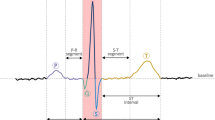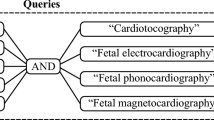Abstract
The fetal electrocardiogram (fECG) contains important information regarding the health of the fetus. However, the fECG obtained noninvasively from the abdominal surface electrical recordings of a pregnant woman are dominated by strong interference from the maternal electrocardiogram (mECG). In this paper, based on the H ∞ principle, two adaptive algorithms are proposed for the extraction of fECG from the trans-abdominal recordings of pregnant women. The motivation behind the application of H ∞ techniques is the fact that they are robust with respect to model uncertainties and lack of statistical information regarding noise. The proposed algorithms are applied to simulated as well as real multichannel ECG recordings and their performances are compared to that of the well-known least-mean-square (LMS) adaptive algorithm. It is found that the proposed H ∞ based algorithms perform superior to the LMS algorithm in extracting the fECG signal.









Similar content being viewed by others
Notes
References
Abboud S, Barkai G, Mashiach S, Sadeh D (1990) Quantification of the fetal electrocardiogram using averaging technique. Comput Biol Med 20:147–155
Assaleh K (2007) Extraction of fetal electrocardiogram using adaptive neuro-fuzzy inference systems. IEEE Trans Biomed Eng 54(1):59–68
Assaleh KT, Al-Nashash HA (2004) Non-iterative method for two-lead fetal ECG extraction. In: Proceedings of the 26th annual international Conference of the IEEE EMBS. San Francisco, pp 1–5
Bryson AE, Ho YC (1975) Applied optimal control. Wiley, New York
Callaerts D (1989) Signal separation based on singular value decomposition and their application to the real time extraction of the fetal electrocardiogram from cutaneous recordings. Ph.D. Thesis, E.E. Dept, KU Leuven
Camps G, Martinez M, Soria E (2001) Fetal ECG extraction using an FIR neural network. Comput Cardiol 28:249–252
Cardoso J-F, Laheld BH (1996) Equivariant adaptive source separation. IEEE Trans Signal Process 44:3017–3030
Crowe JA, Peasgood W, Woolfson MS (1992) Extraction of the abdominal fetal electrocardiogram for use as an indicator of antenatal fetal status. In: Proceedings of annual international conference on IEEE engineering in medicine and biology Society, vol 6, pp 2499–2500
Datian Y, Yu C, Qin G (1998) Wavelet analysis method for processing and recognition of abdominal fetal ECG waveform. In: Proceedings of IEEE international conference electronics, circuits, and systems, vol 3, pp 121–124
De Lathauwer L, De Moor B, Vandewalle J (2000) SVD-based methodologies for fetal electrocardiogram extraction. In: Proceedings of the IEEE international conference on acoust speech, signal processing, pp 3771–3774
Flower RS, Finlay VCD (1978) The electrocardiogram of the neonate. The fetal circulation, pp 72–80
Handbook of electromedicine: basic principles, applications, equipment (1985) In: Kresse H (Ed) Siemens, Chichester. Initiated by J. Patzold
Hassibi B, Kailath T (1995) H ∞ Adaptive filtering. In: Procceedings of ICASSP’95, pp 949–952
Hassibi B, Sayed AH, Kailath T (1996) Linear estimation in Krein spaces-part I: theory & part II: applications. IEEE Trans Autom Control 41:18–49
Hassibi B, Sayed AH, Kailath T (1996) H ∞ optimality of the LMS algorithm. IEEE Trans Signal Proc 44(2):267–280
Jafari MG, Chambers JA (2005) Fetal electrocardiogram extraction by sequential source separation in the wavelet domain. IEEE Trans Biomed Eng 52(3):390–400
Kalman RE (1960) A new approach to linear filtering and prediction problems. Trans ASME J Basic Eng 82:25–45
Kam A, Cohen A (1998) Maternal ECG elimination and fetal ECG detection—comparision of several algorithms. In: Proceedings of annual international conference IEEE engineering in medicine and biology society, vol 1, pp 174–177
Kanjilal PP, Palit S, Saha G (1997) Fetal ECG extraction from single-channel maternal ECG using singular value decomposition. IEEE Trans Biomed Eng 44:51–59
Kao T, Wu KL, Yu BC, Hung JH (1989) Digital signal enhancement of the abdominal fetal ECG. In: Proceedings of annual international conference IEEE engineering in medicine and biology society, vol 2, pp 771–772
Lathauwer LD, Moor BD, Vandewalle J (2000) Fetal electrocardiogram extraction by blind source subspace separation. IEEE Trans Biomed Eng 47(5):567–572
Lilja H, Larlsson K, Lindecrantz K, Ratnam SS, Thavarasah AS, Rosen KG (1989) Microprocessor based waveform analysis of the fetal electrocardiogram during labor. Int J Gynecol Obstet 30:106–116
Lindsley DB (1942) Heart and brain potentials of human fetuses in utero. Am J Psychol 55:412–416
Marossero DE, Erdogmus D, Euliano N, Principe JC, Hild KE (2003) Independent components analysis for fetal electrocardiogram extraction: a case for the data-efficient mermaid algorithm. In: Procceedings of the IEEE XIII workshop on neural networks for signal processing
Marvel CJ, Kirk DL, Jenkins HM, Symonds EM (1980) Normal condition of the fetal electrocardiogram during labour. Br J Obstet Gynaecol 92:611–617
Matonia A, Jazewski J, Kupka T, Horoba K, Wrobel J (2003) Algorithm for recognition and suppression of interfering maternal electrocardiagraphy. In: Proceedings of the computer recognition systems, pp 55–61
Matonia A, Jezewski J, Kupka T, Horoba K, Wrobel J, Gacek A (2006) The influence of coincidence of fetal and maternal QRS complexes on fetal heart rate reliability. Med Biol Eng Comput 44(5):393–403
McSharry P, Clifford G, Tarassenko L, Smith L (2003) A dynamical model for generating synthetic electrocardiogram signals. IEEE Trans Biomed Engg 50(3):289–294
Nandi AK, Zarzoso V (1997) Fetal ECG separation. Inst Elect Eng Colloq. Use of model based digital signal processing techniques in the analysis of biomedical signals pp 8/1–8/6
Pieri JF, Crowe JA, Hayes Hill BR, Spencer CJ, Bhogal K, James DK (2001) Compact long-term recorder for the transabdominal fetal and maternal electrocardiogram. Med Biol Eng Comput 39:118–125
Rosen KG, Luzietti R (2001) Intrapartum fetal monitoring: basis and current developments. Prenat Neonatal Med 9:1–14
Selvan S, Srinivasan R (2000) Recurrent Neural Network based adaptive filtering technique for the extraction of fetal electrocardiogram. Private Communications
Shyu LY, Huang CF, Wu YS, Hu WC, Chao KC (1996) The use of thoracic-abdominal transfer function in extracting fetal electrocardiogram. In: Proceedings of annual international conference IEEE engineering in medicine and biology society, vol 4, pp 1644–1645
Sibony O, Fouillot JP, Bennaoudia M, Benhala A, Blot P (1994) Quantification of the fetal heart rate variability by spectral analysis of fetal well being and fetal distress. Eur J Obstet Gynaecol Reprod Biol 54:103–108
Smyth CN (1953) Electrocardiography of the fetus. Lancet 1:1124–1126
Vanderschoot J, et al. (1987) Two methods for optimal MECG elimination and FECG detection from skin electrode signals. IEEE Trans Biomed Eng 34:233–243
Vigneron V, Paraschiv-Ionescu A, Jutten C (2003) Fetal Electrocardiogram extraction based on non-stationary ICA and wavelet denoising. In: Proceedings of ISSPA, Paris, pp 1–4
Widrow B, et al. (1975) Adaptive noise cancellation: principles and applications. Proc IEEE 63:639–652
Zarzoso V, Nandi AN (2001) Noninvasive fetal electrocardiogram extraction: blind separation versus adaptive noise cancellation. IEEE Trans Biomed Eng 48(1):12–18
Acknowledgments
Author expresses his gratitude to Prof. J.W.M Bergmans and Dr. J.J.M Kierkels of the Technical University of Eindhoven (TU/e) for providing the required data attributing to the successful completion of this work. Author also expresses his gratitude to his project student Mr.Kiran Gopinathan Nambiar for his help in performing the computer simulation works.
Author information
Authors and Affiliations
Corresponding author
Rights and permissions
About this article
Cite this article
Puthusserypady, S. Extraction of fetal electrocardiogram using H ∞ adaptive algorithms. Med Bio Eng Comput 45, 927–937 (2007). https://doi.org/10.1007/s11517-007-0235-5
Received:
Accepted:
Published:
Issue Date:
DOI: https://doi.org/10.1007/s11517-007-0235-5




